Professional bike fits are good, but what if they're too expensive or inconvenient?
There are tons of online bike fit calculators that aim to help riders achieve a good bike fit at home. These tools range from simple bike size calculators to more in-depth fit calculators that try to replicate what you might get from a professional, in-person bike fit. So which fit calculators are actually useful and which are bogus? I tested out some of the most popular ones to find out.
[button]Shop Bikes[/button]
The Best Bike Sizing & Fit Calculators: My Picks
- Best Bike Frame Sizing & Saddle Height Calculator: Specialized / Retül
- Best In-Depth Bike Fit Calculator: Wrench Science Fit System
If you want to figure out what size bike to buy, or just need a good starting point for setting your saddle height on a new bike, then the Specialized / Retül app on the Specialized website was the most accurate one I tried.
If you’re looking for more detailed recommendations for your riding position like frame stack and reach, saddle setback, stem length, bar width, and saddle-to-bar drop, then I found the Fit System calculator on Wrench Science to be the easiest to use and it provided the clearest and most realistic results.
Read on to learn more about out why these are my picks.
The Best Basic Frame Size Calculator
If you’re a newer rider, choosing the correct bike size can be a daunting task, especially when you’re shopping online and can’t test-ride a bike.
Fortunately, there are dozens of basic sizing calculators available. Most use your height, some use your inseam, and some use both. I found some decent calculators, but many tended to choose bike sizes that I considered too small or too large. In general, the results of any basic online sizing calculator should be taken with a grain of salt.
 The Omni bike fit calculator is simple, and for me, fairly accurate.
The Omni bike fit calculator is simple, and for me, fairly accurate.
One basic calculator that I found produced good results (for me) was the Omni Calculator. It gives good instructions on how to properly measure your inseam (your true inseam is NOT your pant inseam) and the calculator ended up picking the current frame size I ride. It also provides some other frame sizes options that can work. This is important, because most riders can actually fit a range of bike frame sizes, and sizing can vary depending on the manufacturer.
 The Specialized / Retül calculator picked the correct frame size, but it also nailed my saddle height.
The Specialized / Retül calculator picked the correct frame size, but it also nailed my saddle height.
Omni was going to be my recommendation until I tried the Retül Fit App on the Specialized website. Unlike other sizing calculators, the Retül uses your height and shin length (it explains how to measure your shin in the App). Retül has collected fit data from tens of thousands of riders around the world. Just by using your height and shin length, it’s able to estimate your ideal frame size and saddle height.
For me, the results were shockingly good. It chose the frame size I generally ride, but more impressively, it provided a saddle height measurement within a few millimeters of the saddle height my Retül fitter landed at after my last in-person bike fit. This gives me a lot of confidence in this tool.
A few caveats: the recommended frame size is for a Specialized road/gravel bike and sizing can vary between brands, so keep that in mind. Also, that the saddle height recommendation is just a starting point. You will likely have to adjust it a bit higher or lower after actually riding it. Make sure you follow the instructions and measure your shin accurately too. I noticed that being off by half an inch would drastically affect the results.
Finding the Best Online Bike Fit Calculator
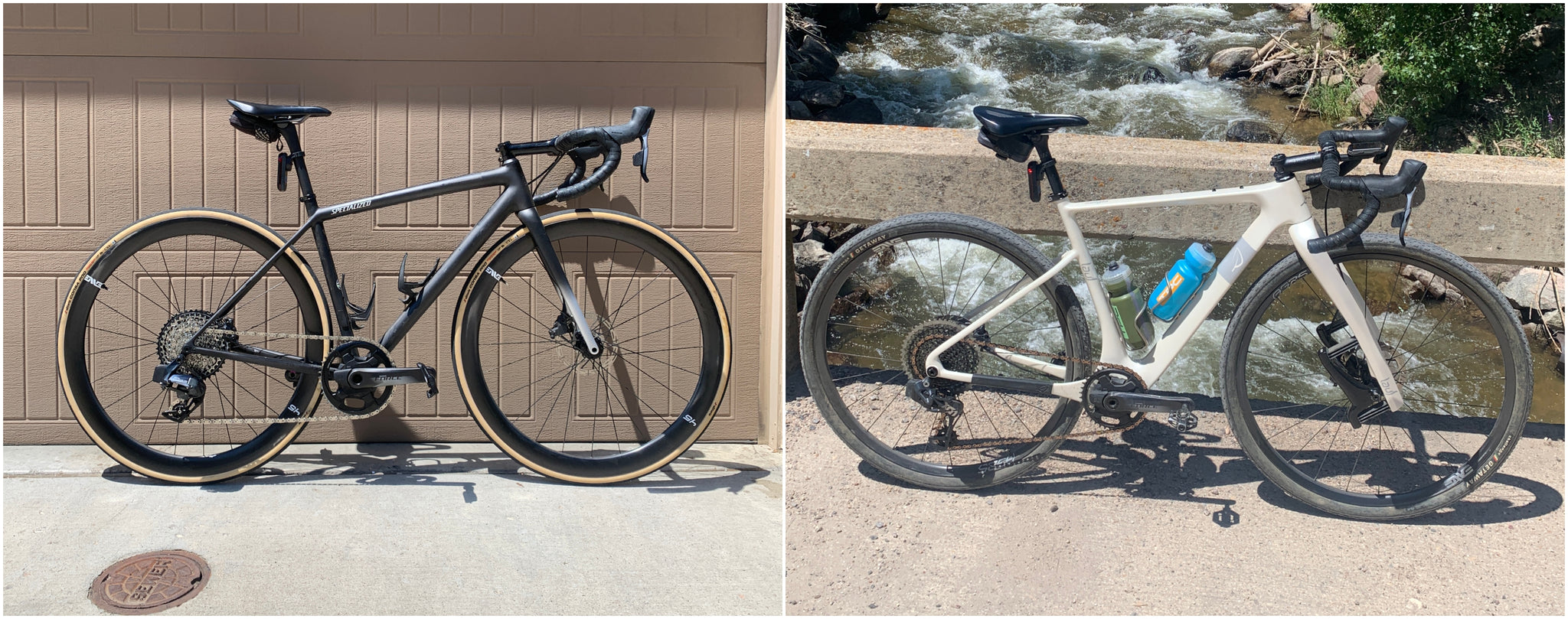 My current bikes are super comfortable and I'll be using them as reference points. The fit for both bikes has been refined over the last year with help from my Retül fitter.
My current bikes are super comfortable and I'll be using them as reference points. The fit for both bikes has been refined over the last year with help from my Retül fitter.
If you’re getting more serious about cycling, then a professional bike fit is one of the best investments you can make. This goes beyond picking the right frame size or setting your saddle height. An actual professional bike fitter will help tweak your touch points (saddle, handles, pedals) and your riding position so that you're more comfortable and efficient. This will also help you prevent injuries or accommodate for any pre-existing injuries.
For years, my go-to for bike fitting has been Retül. I consider it to be the best in the business, but it can cost $300-500 depending on the fitter and any additional components (e.g., saddles, stems, or handlebars) you might need to purchase after the fit. As a result, not many riders actually get professionally fit because it can be too expensive or time-consuming.
This is where online fit calculators come in handy. Of course, there’s no way that an online calculator can achieve the accuracy or nuance you get from an actual in-person bike fit. But they can give riders a good starting point to dial in their bike fit at home.
Here are the three most popular online bike fit calculators that I tried:
Yes, these are all competitors of TPC. We don't offer anything similar, so it's what I have to work with.
All of these calculators use essentially the same measurements to determine your bike fit: height, sternal notch, inseam, torso, upper and lower arms, and upper and lower legs. They also give you options for how “aggressive” you want your fit to be, ranging from race-oriented to comfort-oriented.
My opinions on these calculators is based on how the results compare to my real-world road and gravel bikes and fit, which have all been dialed in over the last 15 years and refined with help from a professional bike fitter at Retül.
Here's a basic rundown of my numbers after my last Retül fit:
|
Height |
5’ 8.5” |
|
Inseam |
30.5” |
|
Current nominal bike size |
52cm / Small |
|
Current ETT |
531mm (road) / 544mm (gravel) |
|
Current reach |
380mm / 383mm |
|
Current stack |
527mm / 537mm |
|
Stem length |
120mm |
|
Bar width |
400mm |
|
Saddle height |
691mm |
|
Saddle setback |
72mm |
|
Saddle-to-bar drop |
91mm / 84mm |
|
Cockpit length |
560mm /555mm |
1st Place: The Wrench Science Fit System Calculator
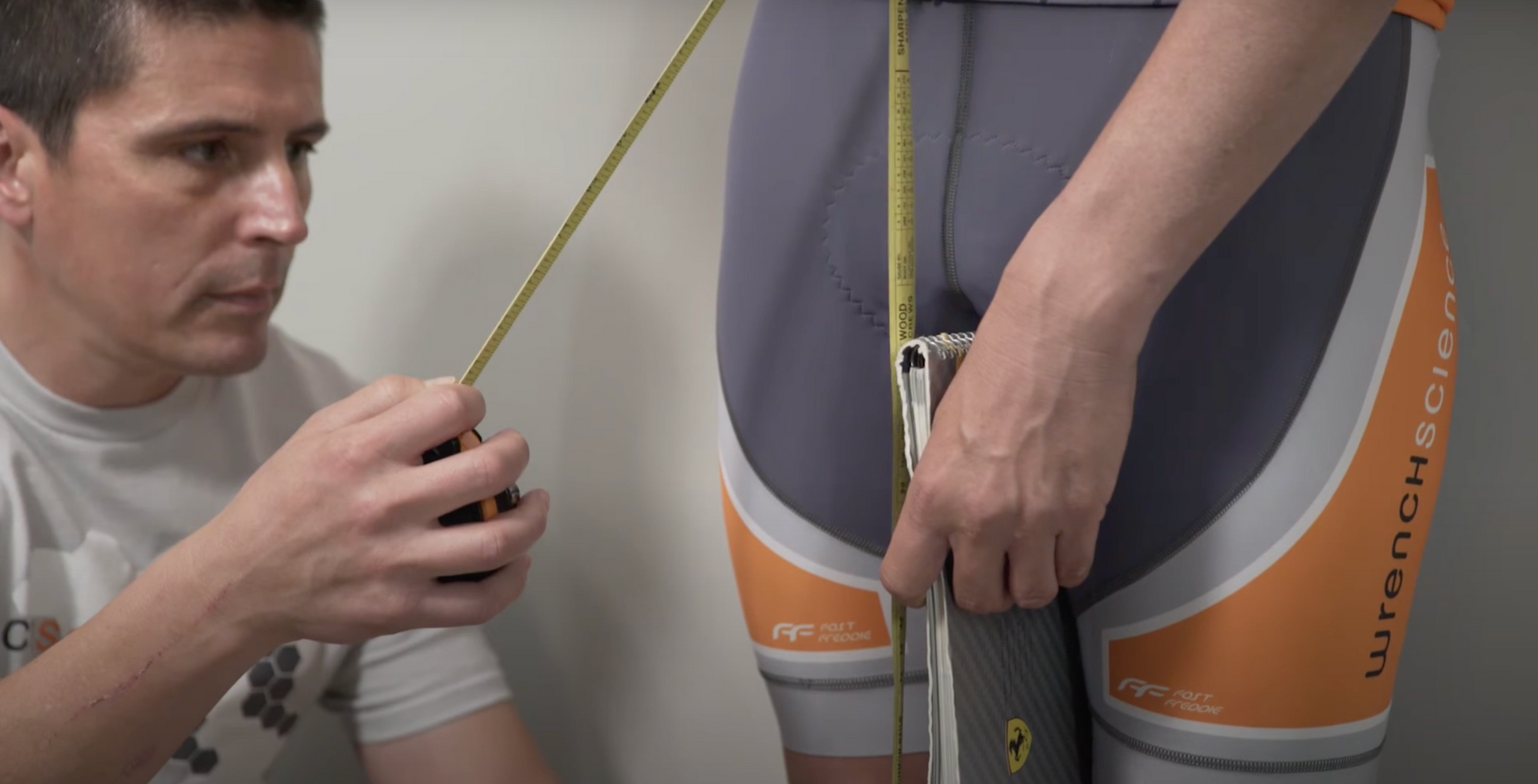 Wrench Science had the best demonstrations for how to take accurate measurements.
Wrench Science had the best demonstrations for how to take accurate measurements.
Wrench Science is my pick for the best calculator. There are a few reasons for this. First off, it adds shoulder width and most importantly, flexibility (which is easily measured using their flexibility chart) to its measurements to further refine its recommendations.
I also really appreciated that Wrench Science includes videos showing you how to take each measurement properly. Measuring accurately is the hardest part of using any of these calculators and I found the explanations on Competitive Cyclist and Jenson to be occasionally vague or confusing. I highly recommend having someone else help you measure yourself too. It makes it so much easier to get good, accurate measurements. The Wrench Science calculator also allows you to input decimals for your measurements.
Ultimately though, it’s the results that matter. Wrench Science won for me because it produced the results closest to my current road and gravel bike fit.
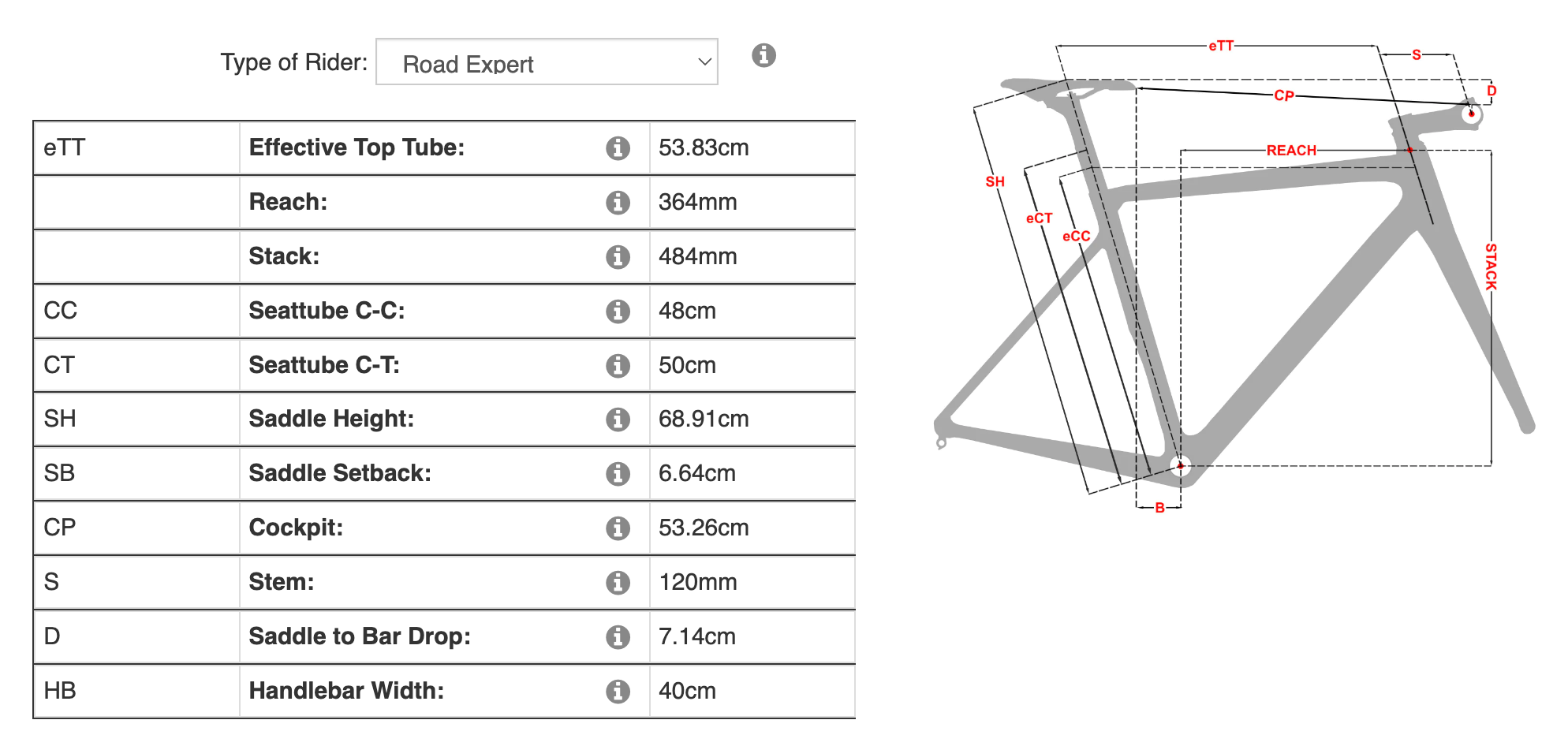 The Wrench Science Fit System calculator came very close to my Retül fit in several areas. I was very impressed.
The Wrench Science Fit System calculator came very close to my Retül fit in several areas. I was very impressed.
Here is what the Wrench Science calculator nailed:
- Top tube length
- Saddle height
- Saddle set back
- Stem length
- Bar width
All of these measurements were either spot on or within 10mm of my current bike and fit measurements. It was the only calculator to suggest an effective top tube length and stem length close to what I actually ride. The saddle height and setback were also impressively close.
Here is what I considered misses:
- Frame stack
- Frame reach
- Cockpit (distance from saddle tip to bars)
- Saddle to bar drop
Of the four, the frame stack was the most egregious. It recommended a frame with a 484mm stack height, which is absurdly low. My current road frame has a stack height of 527mm, and I can probably only comfortably go 10-15mm lower. In fact, I’m not sure any bike in my size exists with a stack height that low, and if it did, I wouldn’t want to ride it. I remeasured and tested the calculator multiple times, using both inches and centimeters, and it seems like the stack height recommendation is just a wonky on the Wrench Science calculator, so I’d just ignore it.
Also, even though it picked my current stem length, the suggested frame reach is almost 20mm less than both of my current bikes, so I put that as a miss. As for saddle-to-bar drop, it's technically off, but I actually think for someone who doesn't want to run their cockpit as low and aggressive as me, it's probably a fine recommendation.
2nd Place: Competitive Cyclist Fit Calculator
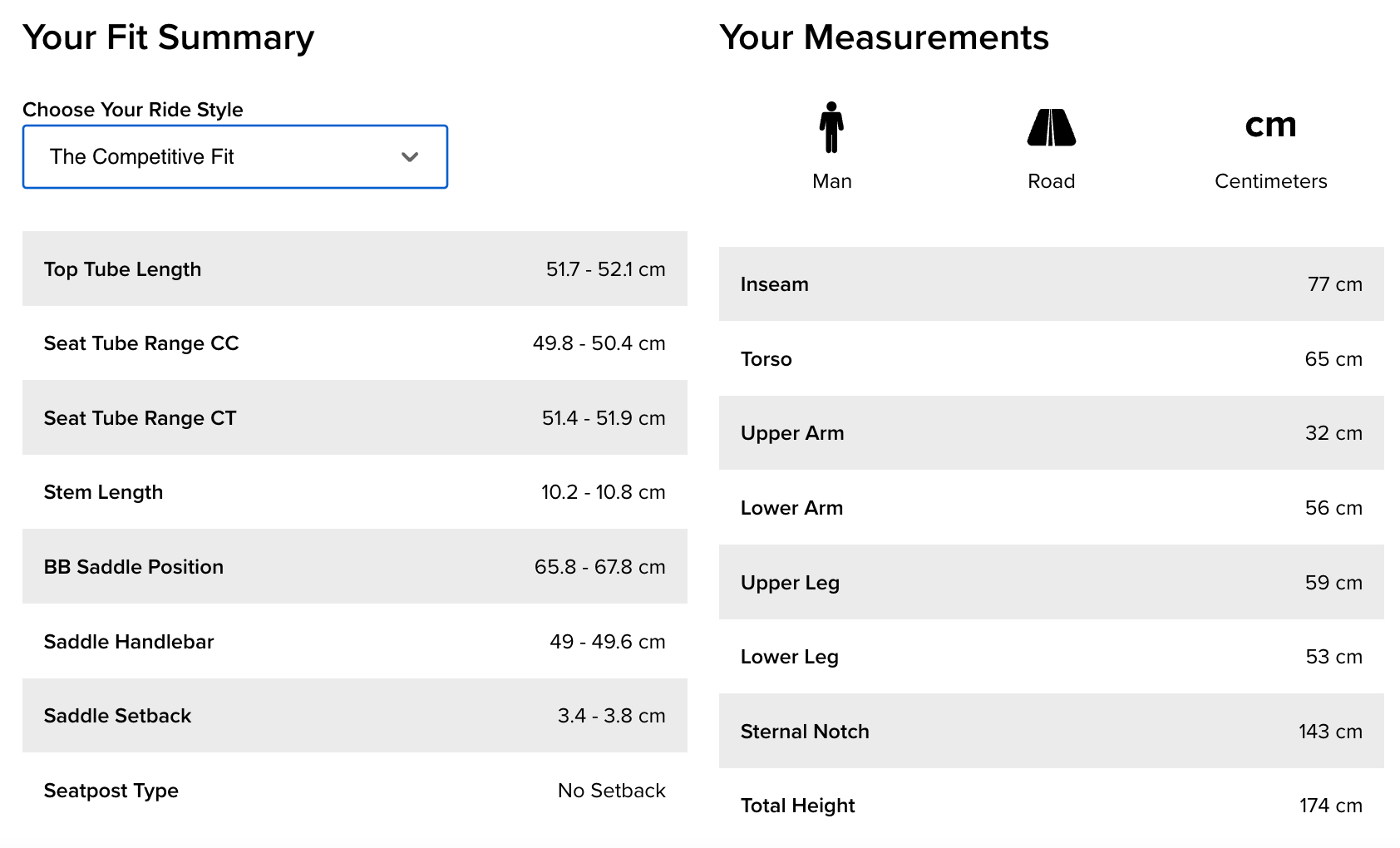 The closest to my current fit was the "competitive" fit option, but it's still pretty far off.
The closest to my current fit was the "competitive" fit option, but it's still pretty far off.
Of the three calculators listed here, the Competitive Cyclist’s fit calculator is probably the longest-standing and the most commonly referenced. It’s been around for at least 15 years or more. I remember using it way back in 2007 to set up my road bike. As far as I can tell, it's remained unchanged since then, which might not be a good thing.
The most annoying thing about this calculator is that you can't input decimals. So for important measurements like inseam, it puts me in a weird spot where I have to round up or down. I think this has to affect the results negatively. For example, the saddle height is quite off. If I round up, it's too high. Round down and it's too low.
The calculator also put me on a frame and stem combo that is much shorter than what I currently ride. I think this happened because the calculator doesn’t account for flexibility the way Wrench Science does. I have good hip mobility and hamstring flexibility and have been riding in long and low positions for over 10 years.
If I didn’t have my current flexibility, then the shorter frame and stem Competitive Cyclist recommends would probably feel more comfortable. In fact, when I took several months off after having my son, I had to temporarily shorten my stem 10mm because I lost some flexibility (and gained weight), so maybe it's more applicable if you lack flexibility or are searching for a more upright and comfortable fit.
Also, not that this should matter to recreational riders, but I found it interesting that the "Competitive" fit suggested a saddle setback that isn't technically UCI legal (50mm is the minimum).
Last Place: Jenson Bike Fit Calculator
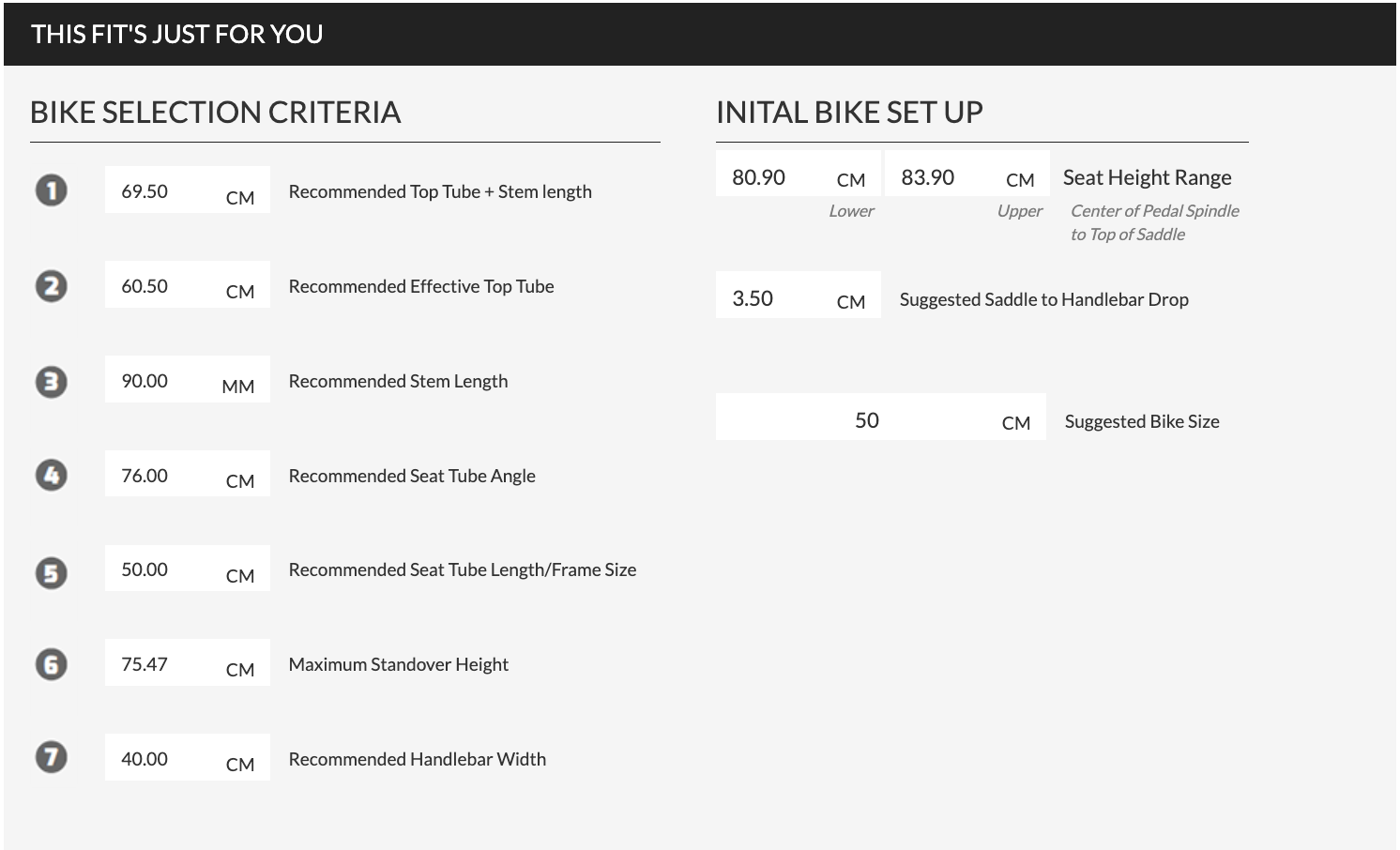 I couldn't make sense of how Jenson's calculator arrived at these wild numbers.
I couldn't make sense of how Jenson's calculator arrived at these wild numbers.
As for Jenson’s calculator. It was wildly off in nearly every measurement. The recommended top tube length and saddle height are both comically large, especially since it also suggested that I ride a much smaller 50cm frame (I generally ride a 52-54cm) with a 90mm stem, which didn't make any sense to me.
I remeasured and tested it multiple times and switched between inches and centimeters for my measurements. Every time it was just flat-out wrong. Overall, I was really confused with the results, so I wouldn’t recommend using Jenson’s calculator.
Final Thoughts
Based on my own test, the Wrench Science Fit System is the best free online fitting tool available. It’s easy to use and fairly accurate. I’ll provide this disclaimer though, I am a sample size of one. A different rider with different body proportions and riding needs might have very different results.
I have good flexibility and like a low and aggressive fit. I actually think both the Wrench Science and Competitive Cyclist calculators will probably work best for newer or more relaxed riders who want a fit that is slightly more upright.
Also, all of these calculators miss out on some other key bike fit elements that an actual in-person bike fitter can help you with:
- Saddle shape and width
- Saddle tilt
- Q-factor
- Crank length
- Cleat position
- Handlebar/shifter hood angle
- Aches and pains
That last point is a big one. Talking to an experienced and knowledgeable fitter who understands the human body can be a huge help if you're experiencing pain on your bike. My bike fitter helped cure my knee pain, and I'll keep going back to him because I trust him to keep me pain free.
Again, an online fit calculator should only be used as a starting point. You can use it to set up your initial stem length, bar height, and saddle position, and as you ride more and get more experienced, you’ll likely begin to understand what you need to tweak to improve your comfort and performance.
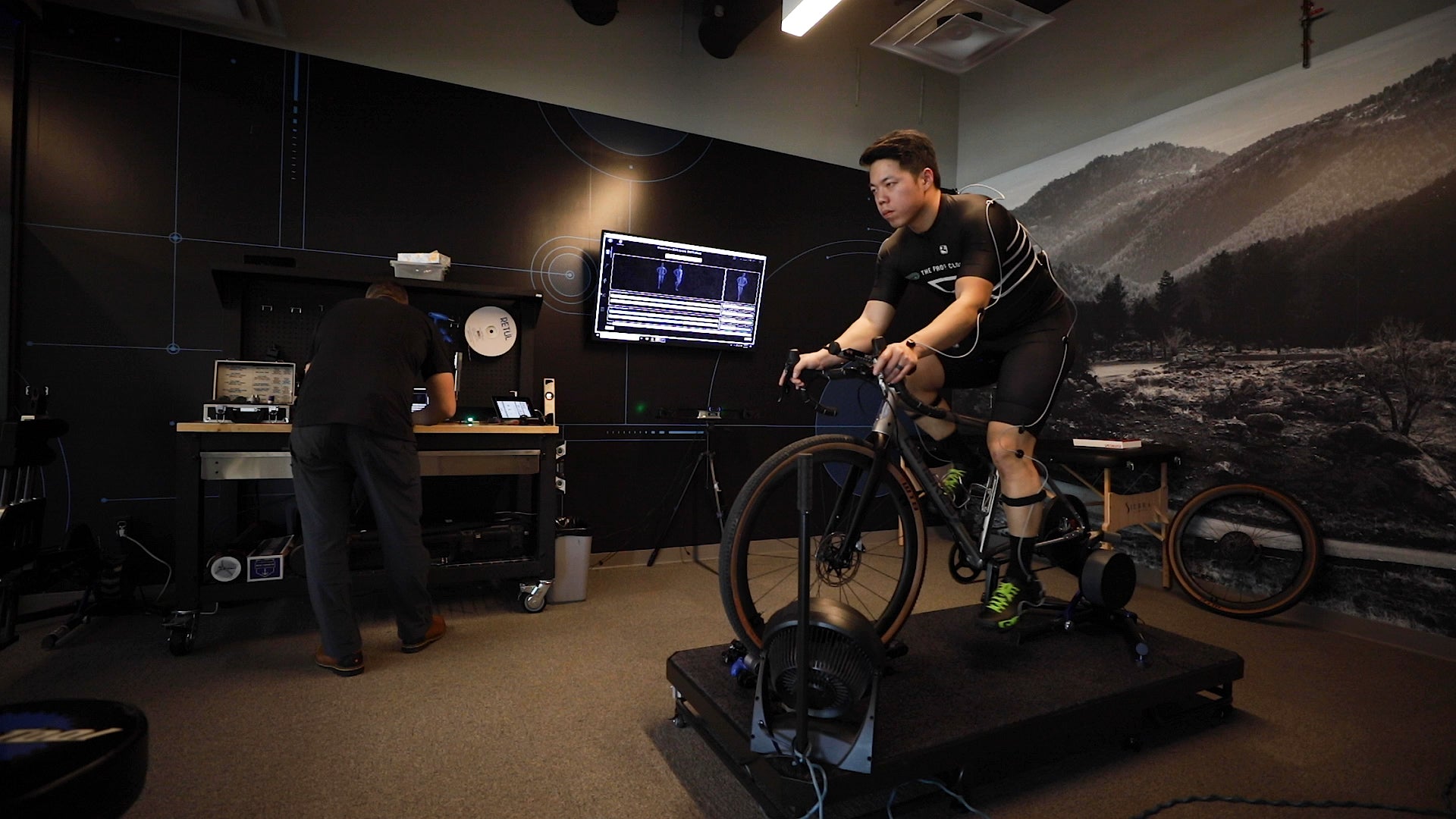 In-person professional bike fits are the next step.
In-person professional bike fits are the next step.
If you find yourself struggling to get your bike to feel comfortable, however, then it’s probably time to visit a professional. I use Retül because I like the motion capture technology they use and I love that they provide a detailed "Fit Report" that can help you replicate your fit on multiple bikes (my most recent Fit Report is what I compared these online calculators against).
[button]Read About My Bike Fit Experience[/button]
There are fiter that will charge less than Retül, and really, any reputable fitter with enough experience should be able to get your riding position close to where it needs to be. I hope this write-up helped. Good luck tinkering with your bike! May you experience thousands of pain-free miles.
[button]Shop Bikes[/button]

























